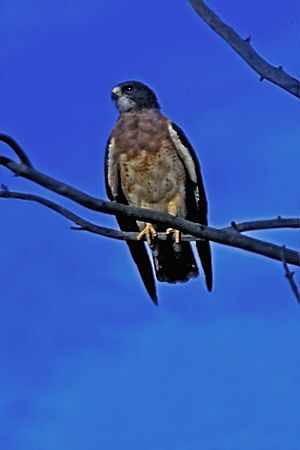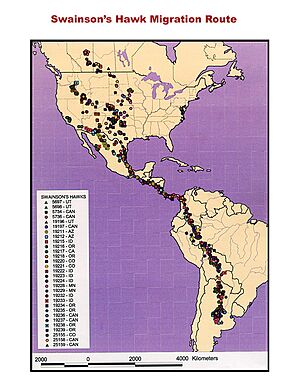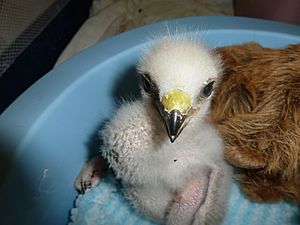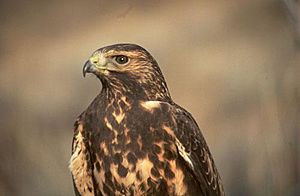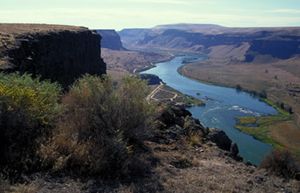Swainson's hawk facts for kids
Quick facts for kids Swainson's hawk |
|
|---|---|
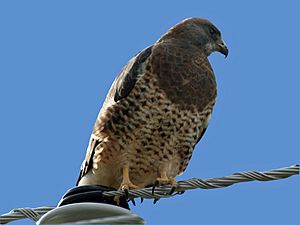 |
|
| Male in California, USA | |
| Conservation status | |
| Scientific classification | |
| Genus: |
Buteo
|
| Species: |
swainsoni
|
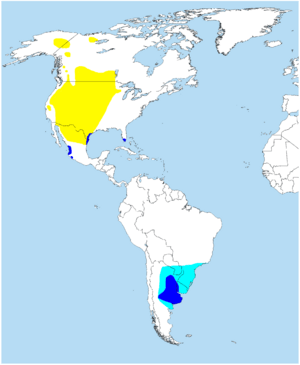 |
|
| Distribution of Swainson's Hawk | |
| Synonyms | |
|
Buteo swainsonii (lapsus) |
|
The Swainson's hawk (Buteo swainsoni) is a large bird of prey. It belongs to the group called Accipitriformes. This bird was named after William Swainson, a British naturalist. People sometimes call it the grasshopper hawk or locust hawk. This is because it loves to eat insects like locusts and grasshoppers. They will eat many of these insects when they can find them.
These hawks build their nests in prairies and dry grasslands in western North America. They make a stick nest in a tree, a bush, or on a cliff. Swainson's hawks are long-distance migrants. This means they fly very far for winter. They spend winter in Argentina. Sometimes, they are seen in places like Chile, the Dominican Republic, Trinidad and Tobago, and even Norway.
Scientists believe this hawk is the ancestor of the Galápagos hawk. Research shows they separated from mainland birds about 300,000 years ago. This is a very short time in evolution.
Contents
What Does a Swainson's Hawk Look Like?
The Swainson's hawk is a raptor. It is a medium-sized member of the Buteo group. It is similar in size to the red-tailed hawk. Red-tailed hawks live in almost all of North America.
Swainson's hawks are usually 43–56 cm (17–22 in) long. They weigh about 0.5–1.7 kg (1.1–3.7 lb). Their wingspan is a bit longer than a red-tailed hawk's. It can be 117–137 cm (46–54 in) wide. Their wings are also more slender. Female hawks are a bit bigger and heavier than males. Females weigh about 1.15 kg (2.5 lb), while males weigh about 0.81 kg (1.8 lb).
When flying, the Swainson's hawk holds its wings in a slight "V" shape. It tips back and forth a little while it soars.
There are two main color types for these hawks. More than 90% are light-colored. The dark-colored hawks are more common in the far west.
- Light-colored adults have white undersides. They have a dark, reddish "bib" on their chest. Their throat and face have a clear white patch. When they soar, their underwings look light on the front edge and dark on the back edge. This pattern is special among North American raptors. Their tail is gray-brown with thin dark bands. The top parts of their body are brown. Young birds look similar but have pale spots on dark areas. Light areas, like their sides, have dark spots.
- Dark-colored birds are dark brown. They only have a light patch under their tail. There is also a reddish type that is lighter underneath with red bars. The tails of these dark forms look like the light-colored ones.
Where Do Swainson's Hawks Live and Travel?
Swainson's hawks live in North America during spring and summer. They fly south to South America for the winter. They breed in places like south-central Alberta and central Saskatchewan in Canada. They also breed in parts of the western and central United States. This includes states like Washington, California, Arizona, and Texas.
Some small groups spend winter in southeastern Florida and along the Texas coast. Most Swainson's hawks winter in the grasslands (pampas) of South America. This includes Argentina, Uruguay, and southern Brazil. Hawks from California's Central Valley winter in western Mexico and Central America.
The Swainson's hawk flies one of the longest distances of any North American raptor. Only the arctic-nesting Peregrine falcon flies farther. Their journey from breeding grounds to South America can be as long as 7,100 mi (11,400 km). Each trip can take at least two months.
They leave their breeding areas from August to October. They start their fall migration on clear days when the wind blows in the right direction. Birds fly up high by circling in warm air currents called thermals. Then they glide, slowly losing height, until they find another thermal to rise with. This creates long lines of birds across the sky.
The birds slowly fly south towards Central America. Almost all of them pass through the Isthmus of Panama. Many hawks gather over places like Panama City. In the Andes mountains, they follow a narrow path. They rarely go off course.
In Brazil, migrating birds fly through western states. However, some hawks, even young ones, have been seen far from their usual path. This suggests some birds get lost or spend a whole year in tropical areas instead of just wintering in one spot.
In Uruguay, studies show they are common but spread out in winter. Many arrive in November and are most numerous in December. Flocks of over a hundred birds have been seen.
In spring, they spread out more as they fly back north. They arrive in the southern U.S. in March. The first hawks reach southern Canada in late March. The main migration happens from mid-April onwards.
How Swainson's Hawks Live (Ecology)
The Swainson's hawk lives in open and partly open areas. These include deserts, grasslands, and prairies. They like wild prairies, hayfields, and pastures. They need high places to perch for hunting. They also need small mammals, like young ground squirrels, to feed their babies. The places where Swainson's hawks breed are closely linked to where these small mammals live.
Swainson's hawks protect their territory from other hawks. They gather in groups to feed and migrate. But these gatherings are not social. They are just because there is good food or good flying conditions.
Swainson's hawks, red-tailed hawks, and ferruginous hawks often live in the same areas. They compete for territory and food. Even though they eat similar things, they might choose different nesting spots. For example, Swainson's hawks might prefer areas with scattered trees.
These hawks are usually okay with people. They are attracted to farm work like haying or plowing. This is because these activities can uncover food. Small birds like House sparrows might even nest near a Swainson's hawk's nest.
In their winter homes, they are much more tolerant of each other. Groups of dozens of birds are common. Flocks of over a hundred birds have been seen.
Natal Dispersal: Where Young Hawks Go
Young Swainson's hawks usually return to the areas where they grew up. This is called natal fidelity. Female hawks tend to move farther from their birth nests than males. This might help prevent inbreeding. In some areas, young hawks have moved as far as 310 km (190 mi).
Males that grew up in areas with more food tended to stay closer to home. This suggests they wanted to stay near good hunting spots.
Hunting and Food for Swainson's Hawks
Swainson's hawks hunt in different ways. Many hunt from a perch. They watch for prey from a tree, bush, or telephone pole. Others soar high over open ground, watching for prey below. They might also fly low like a northern harrier or hover like a rough-legged hawk. They often perch on the ground during migration and breeding. When hunting insects on the ground, they might look clumsy but are often successful.
These birds patrol open areas or look for prey from a high spot. They can also catch insects while flying. They take advantage of insects that are stirred up by farm equipment or driven out by fires. A hawk might grab a dragonfly in flight with its foot and quickly move it to its bill. They do something similar to catch bats. If many dragonflies are on the ground due to weather, the hawk will stand near them and pick them off.
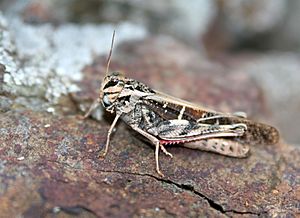
Swainson's hawks often follow tractors and wildfires. This helps them find injured or fleeing food. They will also run after insects on the ground. Sometimes, a hawk will stand still on a dirt mound, waiting for prey.
When not nesting, Swainson's hawks eat mostly insects. Common insect prey includes grasshoppers, crickets, and locusts. Other hawks in this area usually eat rodents and other small animals. However, breeding Swainson's hawks switch to catching small animals for their babies. They eat small mammals like young ground squirrels, young cottontails, pocket gophers, mice, and young jackrabbits. They also eat small birds, reptiles, and amphibians. Reptiles can be a big part of their diet, including snakes and lizards. Amphibians might include tiger salamanders and toads. Swainson's hawks are smart hunters. They quickly use any local source of food.
In Argentina, young Swainson's hawks eat large groups of darner dragonflies. They follow the insect groups and eat mostly while flying. They also eat locusts when there are many of them. Young hawks wintering in Florida eat insects or mice that are uncovered by plowing fields.
They also eat road-killed animals and birds. They often follow farm equipment during haying or plowing. This helps them find rodents or insects. Wildfires also attract them, especially grass fires in South America. At these fires, hawks wait at the edges to catch insects and small animals like lizards and snakes.
Reproduction and Life Cycle
When Swainson's hawks return to their nesting areas in March or April, they often go back to their old nests. These hawks usually mate for life. They are also very loyal to their nesting territory. This is unusual for birds that fly such long distances.
About one to two weeks after they arrive, the males start building nests. They build them on the ground, on ledges, or in trees. The nest is made of twigs and grasses. It can take up to two weeks to finish. They might build new nests, fix old ones, or use old nests from other birds like ravens or black-billed magpies.
The courtship displays of Swainson's hawks are not well known. One display involves circling and diving above a possible nest site. They flash their underwings and call out. The display might end with one bird landing on the nest edge. Mating happens mostly in the morning and evening.
Swainson's hawks usually nest in single trees or bushes. They also nest in groups of trees along rivers or near old farmhouses. Sometimes, a pair will nest on the ground or on a bank. They use trees like ponderosa pines, Douglas-firs, spruce, cottonwoods, and willows. Nests are usually 9 to 15 ft (2.7 to 4.6 m) above the ground. They are often in the shade but near the top of the tree. Their nests are not very strong and often blow down after the nesting season.
A female hawk lays one to four eggs, but usually two or three. Each egg is oval-shaped, about 2.25 in (57 mm) long and 1.8 in (46 mm) wide. The eggs are smooth and white, sometimes with a bluish or greenish tint. Some eggs are plain, while others have light brown spots. The female sits on the eggs for 34 to 35 days. The male brings her food during this time.
Young Swainson's hawks are fed small, young mammals. Their flight feathers start to grow when they are 9 to 11 days old. Many young birds die when they are 15 to 30 days old. This can be due to older siblings harming them. The young birds start to leave the nest for nearby branches at 33 to 37 days old. They learn to fly (fledge) at about 38 to 46 days old. After they fledge, they still depend on their parents for 4 to 5 weeks. These hawks have only one group of babies per year.
The oldest wild Swainson's hawk found lived for 26 years and 1 month. Swainson's hawks can die from hitting cars, illegal shooting, electrocution (electric shock), and severe weather like hailstorms. Wind and hail caused 30% of nests to fail in one study. If they share a grove with great horned owls, the owls might eat their eggs. The species also has problems with eggs that don't hatch for unknown reasons.
Status and Conservation of Swainson's Hawks
The number of Swainson's hawks has gone down since the early 1900s. It was listed as a "Blue-listed" species in the United States from 1972 to 1982. Later, it was put on the National Audubon's List of Special Concern in 1986. The United States Fish and Wildlife Service now lists it as a Category 3C candidate. It was removed from the main federal list because more birds were found than thought. The IUCN does not consider it a threatened species. However, the California Department of Fish and Game still lists it as threatened.
A big reason for the hawk's population drop was the use of pesticides in Argentina, where they spend winter. Farmers used pesticides like DDT to control grasshopper and locust outbreaks. Swainson's hawks ate these insects, which had the pesticides in them. The U.S. has worked with Argentine farmers to help solve this problem.
Swainson's hawks have adapted well to grazing and pasture land. Their numbers seem stable in much of their breeding range. But populations in the far west, like Oregon and southern California, have dropped a lot. This is often due to losing their habitat or certain farming practices. Another reason for declines might be fewer ground squirrels and grasshoppers, which are important food sources.
Even though they often nest near people, some Swainson's hawks are easily bothered at their nests. They might leave their nests, especially early in the season. The bird is often quite calm, making it an easy target for hunters on lonely prairie roads. The species might also be affected by some insecticides and herbicides, including those used in their winter homes.
Where to See Swainson's Hawks
One of the best places to see the Swainson's hawk is in the Snake River Birds of Prey National Conservation Area (NCA) in Idaho. You can most often see these birds in the NCA in mid-March, May, and June. They are easiest to spot in the early morning and evening when they are hunting. In April, they are busy nesting and guarding eggs, so they are harder to find. In July, it gets very hot in the canyon. This makes food scarce, so many birds of prey fly away.
This article includes text from the Bureau of Land Management, which is available for public use.
Images for kids
- BirdLife species factsheet for Buteo swainsoni
- Interactive range map of Buteo swainsoni at IUCN Red List maps
- Audio recordings of Swainson's hawk on Xeno-canto.
See also
 In Spanish: Busardo chapulinero para niños
In Spanish: Busardo chapulinero para niños



